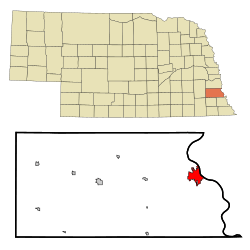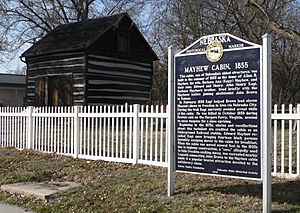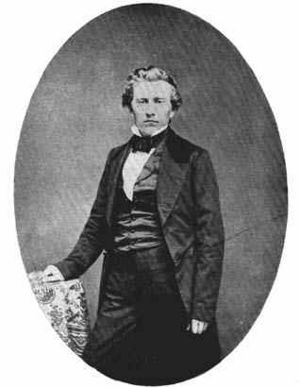Nebraska City, Nebraska facts for kids
Quick facts for kids
Nebraska City, Nebraska
|
|
|---|---|

Arbor Lodge State Historical Park, 2012
|
|

Location of Nebraska City, Nebraska
|
|
| Country | United States |
| State | Nebraska |
| County | Otoe |
| Government | |
| • Type | Mayor-Bryan Bequette Commission |
| Area | |
| • Total | 4.97 sq mi (12.88 km2) |
| • Land | 4.97 sq mi (12.88 km2) |
| • Water | 0.00 sq mi (0.00 km2) |
| Elevation | 1,043 ft (318 m) |
| Population
(2020)
|
|
| • Total | 7,222 |
| • Density | 1,452.24/sq mi (560.73/km2) |
| Time zone | UTC-6 (Central (CST)) |
| • Summer (DST) | UTC-5 (CDT) |
| ZIP code |
68410
|
| Area code(s) | 402 |
| FIPS code | 31-33705 |
| GNIS feature ID | 2395162 |
Nebraska City is a city in the state of Nebraska, United States. It is also the county seat of Otoe County, Nebraska. This means it's where the main government offices for the county are located. In 2020, about 7,222 people lived there.
The state of Nebraska considers Nebraska City to be its oldest incorporated city. This means it was the first city officially approved by the Nebraska Territorial Legislature in 1855.
Nebraska City is famous for a few things. It's known as the home of Arbor Day, a special day for planting trees. It also has the Missouri River Basin Lewis and Clark Center, which teaches about the nature discoveries of the famous Lewis and Clark expedition. You can also find the Mayhew Cabin here. This cabin is the only place in Nebraska recognized as a stop on the Underground Railroad, a secret network that helped enslaved people find freedom.
Contents
Discovering Nebraska City's Past
Early Explorers and Settlements
In 1804, explorers Lewis and Clark traveled along the Missouri River. They were among the first European-Americans to explore this area. They met many Native American tribes who had lived there for thousands of years.
In 1846, the U.S. Army built Old Fort Kearny in Nebraska City. This fort was later moved to central Nebraska. After the fort was empty, John Boulware started an important ferry service. This ferry helped people cross the river from Iowa to what is now Nebraska City. In 1852 or 1853, he built the first house in Nebraska City.
Becoming a City and a Hub
In 1854, the Kansas–Nebraska Act allowed people to legally settle in this area. Three towns were started by settlers, including Stephen Nuckolls, who helped found Nebraska City. Nebraska City and Kearney City became official towns in 1855. South Nebraska City joined them in 1856.
For a while, Nebraska City tried hard to become the capital of the Nebraska Territory. On December 31, 1857, these three towns, along with Prairie City, joined together to form the Nebraska City we know today. Before the American Civil War, Nebraska City had many enslaved people. They often worked on the riverfront, helping to move goods and luggage from steamboats.
In the mid-1800s, steamboats on the Missouri River were very important for Nebraska City's growth. They brought trade, people, and goods to the west. In 1858, a company called Russell, Majors and Waddell started using Nebraska City as a major shipping point. They transported supplies for all the western forts. Goods arrived by steamboat and were then sent out by wagon train. Nebraska City was a great location for this because it had a gentle slope from the river to the land above.
Because of its good location and transportation links, Nebraska City became a key center for trade, business, and farming in the region. Other ways of transport, like the steam wagon and the first locomotive engine of the Midland Pacific, also helped the city grow.
The Birth of Arbor Day
J. Sterling Morton came to Nebraska City in 1855. He worked as an editor for the Nebraska City News. Morton and his wife, Caroline, loved nature. Morton later became the Secretary of Agriculture for President Grover Cleveland. In 1872, he helped create Arbor Day, a day for planting trees. Governor Robert Furnas of Nebraska made the first Arbor Day official on March 31, 1874. This holiday is now celebrated all around the world.
Nebraska City also has its own hospital, St. Mary's Hospital. As the county seat, it has the courthouse and other county offices.
Nebraska City's Location and Weather
Where is Nebraska City?
Nebraska City is located on the western bank of the Missouri River. The United States Census Bureau says the city covers about 4.69 square miles (12.15 square kilometers) of land. There is no water area within the city limits.
Understanding the Climate
| Climate data for Nebraska City, Nebraska (1991–2020 normals, extremes 1961–present) | |||||||||||||
|---|---|---|---|---|---|---|---|---|---|---|---|---|---|
| Month | Jan | Feb | Mar | Apr | May | Jun | Jul | Aug | Sep | Oct | Nov | Dec | Year |
| Record high °F (°C) | 71 (22) |
77 (25) |
89 (32) |
95 (35) |
98 (37) |
106 (41) |
109 (43) |
106 (41) |
102 (39) |
93 (34) |
83 (28) |
73 (23) |
109 (43) |
| Mean maximum °F (°C) | 57.4 (14.1) |
63.0 (17.2) |
76.7 (24.8) |
85.7 (29.8) |
90.4 (32.4) |
93.6 (34.2) |
96.6 (35.9) |
95.7 (35.4) |
92.6 (33.7) |
86.7 (30.4) |
73.1 (22.8) |
60.7 (15.9) |
97.2 (36.2) |
| Mean daily maximum °F (°C) | 33.6 (0.9) |
38.9 (3.8) |
51.8 (11.0) |
63.8 (17.7) |
73.8 (23.2) |
83.1 (28.4) |
86.6 (30.3) |
85.0 (29.4) |
78.7 (25.9) |
66.2 (19.0) |
51.0 (10.6) |
38.3 (3.5) |
62.6 (17.0) |
| Daily mean °F (°C) | 23.7 (−4.6) |
28.3 (−2.1) |
40.2 (4.6) |
51.4 (10.8) |
62.4 (16.9) |
72.2 (22.3) |
76.1 (24.5) |
73.9 (23.3) |
66.2 (19.0) |
53.7 (12.1) |
40.0 (4.4) |
28.7 (−1.8) |
51.4 (10.8) |
| Mean daily minimum °F (°C) | 13.7 (−10.2) |
17.6 (−8.0) |
28.5 (−1.9) |
39.0 (3.9) |
51.1 (10.6) |
61.3 (16.3) |
65.6 (18.7) |
62.8 (17.1) |
53.7 (12.1) |
41.3 (5.2) |
29.0 (−1.7) |
19.1 (−7.2) |
40.2 (4.6) |
| Mean minimum °F (°C) | −6.0 (−21.1) |
0.2 (−17.7) |
9.5 (−12.5) |
25.3 (−3.7) |
37.9 (3.3) |
50.4 (10.2) |
55.9 (13.3) |
52.9 (11.6) |
39.7 (4.3) |
26.0 (−3.3) |
13.7 (−10.2) |
0.5 (−17.5) |
−9.1 (−22.8) |
| Record low °F (°C) | −28 (−33) |
−23 (−31) |
−12 (−24) |
4 (−16) |
27 (−3) |
40 (4) |
41 (5) |
44 (7) |
28 (−2) |
14 (−10) |
−6 (−21) |
−23 (−31) |
−28 (−33) |
| Average precipitation inches (mm) | 0.87 (22) |
1.12 (28) |
1.88 (48) |
3.43 (87) |
5.41 (137) |
4.88 (124) |
4.36 (111) |
2.93 (74) |
3.18 (81) |
3.02 (77) |
1.58 (40) |
1.42 (36) |
34.08 (866) |
| Average snowfall inches (cm) | 8.1 (21) |
7.2 (18) |
1.9 (4.8) |
1.1 (2.8) |
0.1 (0.25) |
0.0 (0.0) |
0.0 (0.0) |
0.0 (0.0) |
0.0 (0.0) |
0.1 (0.25) |
1.3 (3.3) |
4.2 (11) |
24.0 (61) |
| Average precipitation days (≥ 0.01 in) | 4.5 | 4.4 | 6.0 | 8.1 | 9.7 | 8.6 | 7.8 | 7.3 | 6.2 | 6.0 | 4.4 | 4.6 | 77.6 |
| Average snowy days (≥ 0.1 in) | 3.2 | 2.8 | 1.0 | 0.2 | 0.0 | 0.0 | 0.0 | 0.0 | 0.0 | 0.1 | 0.5 | 2.5 | 10.3 |
| Source: NOAA | |||||||||||||
People of Nebraska City
Population Changes Over Time
| Historical population | |||
|---|---|---|---|
| Census | Pop. | %± | |
| 1860 | 1,922 | — | |
| 1870 | 6,050 | 214.8% | |
| 1880 | 4,183 | −30.9% | |
| 1890 | 11,941 | 185.5% | |
| 1900 | 7,380 | −38.2% | |
| 1910 | 5,488 | −25.6% | |
| 1920 | 6,279 | 14.4% | |
| 1930 | 7,230 | 15.1% | |
| 1940 | 7,339 | 1.5% | |
| 1950 | 6,872 | −6.4% | |
| 1960 | 7,252 | 5.5% | |
| 1970 | 7,441 | 2.6% | |
| 1980 | 7,127 | −4.2% | |
| 1990 | 6,547 | −8.1% | |
| 2000 | 7,228 | 10.4% | |
| 2010 | 7,289 | 0.8% | |
| 2020 | 7,222 | −0.9% | |
| U.S. Decennial Census 2013 Estimate |
|||
Who Lives in Nebraska City? (2010 Census)
According to the census from 2010, there were 7,289 people living in Nebraska City. These people lived in 2,960 households, and 1,867 of these were families. The city had about 1554.2 people per square mile.
Most of the people in the city (91.5%) were White. About 10.9% of the population identified as Hispanic or Latino.
In terms of households, 30.7% had children under 18 living there. About 46.1% were married couples living together. The average household had 2.37 people, and the average family had 2.97 people.
The average age in the city was 40.9 years old. About 24.4% of residents were under 18. Also, 19.7% were 65 years or older. The city had slightly more females (52.7%) than males (47.3%).
Fun Things to Do and See
Celebrating Arbor Day
Nebraska City is proudly known as "The Home of Arbor Day". You can visit Arbor Lodge, which was the home of J. Sterling Morton. He was the first Secretary of Agriculture for the United States and worked hard to encourage people to plant trees. The National Arbor Day Foundation has its main office near his home in Nebraska City.
The AppleJack Festival
Every year, Nebraska City hosts the AppleJack Festival. This fun event happens on the third weekend of September and has been going on for over 40 years! It includes a parade, a classic car show, carnival rides, and a fun run or walk. You can also find quilt shows and craft shows all around the city. In 2011, about 40,000 to 50,000 visitors were expected to attend!
Learning and Schools
Education in Nebraska City
Nebraska City is home to the first high school ever built in Nebraska, which opened in 1864.
The city has both public and Catholic school systems. Nebraska City Public Schools offers education from kindergarten through 12th grade. The high school has about 445 students, and their sports teams are called the Pioneers.
Lourdes Central Catholic Schools also provides K-12 education. It has about 330 students in all grades. Their sports teams are known as the Knights.
The Nebraska Center for the Education of Children Who Are Blind or Visually Impaired was started in 1875. Today, it helps students who are blind or have low vision from all over Nebraska and western Iowa.
Famous People from Nebraska City

Many interesting people have connections to Nebraska City:
- Bret Clark — A professional football player.
- Lloyd Fallers — An anthropologist (someone who studies human societies and cultures) at the University of Chicago.
- Leland Hayward — A famous Hollywood and Broadway agent and producer.
- William Hayward — An attorney and commander of the Harlem Hellfighters during World War I.
- Monroe Leland Hayward — A United States Senator-elect from Nebraska.
- George H. Heinke — A lawyer and U.S. Congressman.
- John Henry Kagi — A key person in John Brown's 1859 raid on Harpers Ferry. He also helped create a station at the Mayhew Cabin for the Underground Railroad.
- Mitch Krenk — A professional football player.
- Cheri Madsen — A Paralympic wheelchair racing athlete.
- Joy Morton — Son of J. Sterling Morton, who founded Morton Salt.
- Julius Sterling Morton — The founder of Arbor Day and a former U.S. Secretary of Agriculture.
- Paul Morton — Served as Secretary of the Navy under President Theodore Roosevelt.
- Prudence Neff — A pianist and music teacher.
- Stephen Nuckolls — One of the people who helped found Nebraska City.
- Greg Orton — A professional football player.
- Joe Ricketts — The founder of TD Ameritrade.
- Pete Ricketts — A United States Senator from Nebraska and former Governor of Nebraska.
- Anthony "Lionheart" Smith — A professional mixed martial artist.
- James Gilligan — Served as a director of mental health for the Massachusetts prison system.
See also
 In Spanish: Nebraska City (Nebraska) para niños
In Spanish: Nebraska City (Nebraska) para niños


